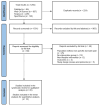Effects of Lifestyle Interventions on the Improvement of Chronic Non-Specific Low Back Pain: A Systematic Review and Network Meta-Analysis
- PMID: 38470617
- PMCID: PMC10931043
- DOI: 10.3390/healthcare12050505
Effects of Lifestyle Interventions on the Improvement of Chronic Non-Specific Low Back Pain: A Systematic Review and Network Meta-Analysis
Abstract
Chronic non-specific low back pain (CNSLBP) is a highly prevalent musculoskeletal condition that has a great socioeconomic impact on health systems. Instead of focusing on mechanical causes and direct workload in the development of CNSLBP, genetics, psychosocial environment, lifestyle and quality of life are coming to the forefront in its approach. The main objective was to analyze whether interventions aimed at modifying lifestyle can be effective in improving pain intensity and functional disability in CNSLBP. A search in PubMed, Web of Science, Scopus and SportDiscus databases was performed. Both a univariate and a multivariate network meta-analysis were applied with the difference pre/post-treatment. A total of 20 studies were included for qualitative analysis, of which 16 were randomized clinical trials with a moderate-high methodological quality and were part of the quantitative analysis. The interventions that had the greatest effect in reducing pain intensity were cognitive therapy combined with functional exercise programs, lumbar stabilization exercise and resistance exercise; meanwhile, for functional disability, they were functional exercise programs, aerobic exercise and standard care. In conclusion, a multimodal intervention aimed at changing one's lifestyle that encompasses cognitive, behavioral, and physical aspects seems to be highly effective in improving pain intensity and functional disability caused by CNSLBP; however, it is not yet known if these improvements are maintained in the long term.
Keywords: functional disability; lifestyle; low back pain; multivariate network meta-analysis; non-specific low back pain; pain intensity; sedentary behavior.
Conflict of interest statement
The authors declare no conflicts of interest.
Figures




References
-
- James S.L., Abate D., Abate K.H., Abay S.M., Abbafati C., Abbasi N., Briggs A.M. Global, regional, and national incidence, prevalence, and years lived with disability for 354 diseases and injuries for 195 countries and territories, 1990–2017: A systematic analysis for the Global Burden of Disease Study 2017. Lancet. 2018;392:1789–1858. doi: 10.1016/S0140-6736(18)32279-7. - DOI - PMC - PubMed
-
- Wu A., March L., Zheng X., Huang J., Wang X., Zhao J., Blyth F.M., Smith E., Buchbinder R., Hoy D. Global low back pain prevalence and years lived with disability from 1990 to 2017: Estimates from the Global Burden of Disease Study 2017. Ann. Transl. Med. 2020;8:299. doi: 10.21037/atm.2020.02.175. - DOI - PMC - PubMed
-
- Cieza A., Causey K., Kamenov K., Hanson S.W., Chatterji S., Vos T. Global estimates of the need for rehabilitation based on the Global Burden of Disease study 2019: A systematic analysis for the Global Burden of Disease Study 2019. Lancet. 2020;396:2006–2017. doi: 10.1016/S0140-6736(20)32340-0. - DOI - PMC - PubMed
Publication types
LinkOut - more resources
Full Text Sources

